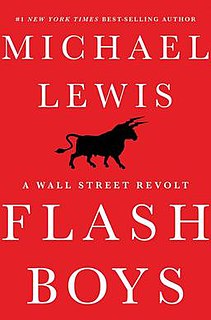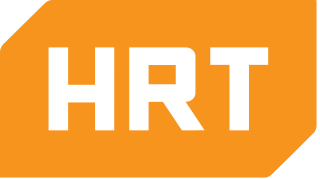Related Research Articles

Day trading is a form of speculation in securities in which a trader buys and sells a financial instrument within the same trading day, so that all positions are closed before the market closes for the trading day to avoid unmanageable risks and negative price gaps between one day's close and the next day's price at the open. Traders who trade in this capacity are generally classified as speculators. Day trading contrasts with the long-term trades underlying buy and hold and value investing strategies. Day trading can be considered a form of gambling. It is made easier using day trading software.
Algorithmic trading is a method of executing orders using automated pre-programmed trading instructions accounting for variables such as time, price, and volume. This type of trading attempts to leverage the speed and computational resources of computers relative to human traders. In the twenty-first century, algorithmic trading has been gaining traction with both retail and institutional traders. It is widely used by investment banks, pension funds, mutual funds, and hedge funds that may need to spread out the execution of a larger order or perform trades too fast for human traders to react to. A study in 2019 showed that around 92% of trading in the Forex market was performed by trading algorithms rather than humans.

A trading room gathers traders operating on financial markets. The trading room is also often called the front office. The terms "dealing room" and "trading floor" are also used, the latter being inspired from that of an open outcry stock exchange. As open outcry is gradually replaced by electronic trading, the trading room becomes the only remaining place that is emblematic of the financial market. It is also the likeliest place within the financial institution where the most recent technologies are implemented before being disseminated in its other businesses.
An automated trading system (ATS), a subset of algorithmic trading, uses a computer program to create buy and sell orders and automatically submits the orders to a market center or exchange. The computer program will automatically generate orders based on predefined set of rules using a trading strategy which is based on technical analysis, advanced statistical and mathematical computations or input from other electronic sources.

In finance, a dark pool is a private forum for trading securities, derivatives, and other financial instruments. Liquidity on these markets is called dark pool liquidity. The bulk of dark pool trades represent large trades by financial institutions that are offered away from public exchanges like the New York Stock Exchange and the NASDAQ, so that such trades remain confidential and outside the purview of the general investing public. The fragmentation of electronic trading platforms has allowed dark pools to be created, and they are normally accessed through crossing networks or directly among market participants via private contractual arrangements. Generally dark pools are not available to the public, but in some cases they may be accessed indirectly by retail investors and traders via retail brokers.
Trading the news is a technique to trade equities, currencies and other financial instruments on the financial markets. Trading news releases can be a significant tool for financial investors. Economic news reports often spur strong short-term moves in the markets, which may create trading opportunities for traders. Announcements about corporate profits, a change in management, rumors of a merger, are events that can cause a company's share price to move wildly up or down. Interest rates, unemployment and export rates, or the central bank's policy shifts, can cause a deep change of an exchange rate.
High-frequency trading (HFT) is a type of algorithmic financial trading characterized by high speeds, high turnover rates, and high order-to-trade ratios that leverages high-frequency financial data and electronic trading tools. While there is no single definition of HFT, among its key attributes are highly sophisticated algorithms, co-location, and very short-term investment horizons. HFT can be viewed as a primary form of algorithmic trading in finance. Specifically, it is the use of sophisticated technological tools and computer algorithms to rapidly trade securities. HFT uses proprietary trading strategies carried out by computers to move in and out of positions in seconds or fractions of a second.
Flash trading, otherwise known as a flash order, is a marketable order sent to a market center that is not quoting the industry's best price or that cannot fill that order in its entirety. The order is then flashed to recipients of the venue's proprietary data feed to see if any of those firms wants to take the other side of the order.

The May 6, 2010, flash crash, also known as the crash of 2:45 or simply the flash crash, was a United States trillion-dollar stock market crash, which started at 2:32 p.m. EDT and lasted for approximately 36 minutes.
A flash crash is a very rapid, deep, and volatile fall in security prices occurring within a very short time period. A flash crash frequently stems from trades executed by black-box trading, combined with high-frequency trading, whose speed and interconnectedness can result in the loss and recovery of billions of dollars in a matter of minutes and seconds.
Scott Patterson is an American financial journalist and bestselling author. He is a staff reporter at The Wall Street Journal and author of Dark Pools: High-Speed Traders, A.I. Bandits, and the Threat to the Global Financial System and The New York Times bestselling bookThe Quants.
Layering is a strategy in high-frequency trading where a trader makes and then cancels orders that they never intend to have executed in hopes of influencing the stock price. For instance, to buy stock at a lower price, the trader initially places orders to sell at or below the market ask price. This may cause the market's best ask price to fall as other market participants lower their asking prices because they perceive selling pressure as they see the sell orders being entered on the order book. The trader may place subsequent sell orders for the security at successively lower prices as the best ask price falls. After the price has fallen sufficiently, the trader makes a real trade, buying the stock at the now lower best ask price, and cancels all the sell orders. It is considered a form of stock market manipulation.

Virtu Financial is one of the largest providers of financial services, trading products and market making services. Virtu provides product suite including offerings in execution, liquidity sourcing, analytics and broker-neutral, multi-dealer platforms in workflow technology and two-sided quotations and trades in equities, commodities, currencies, options, fixed income, and other securities on over 230 exchanges, markets, and dark pools. Virtu uses proprietary technology to trade large volumes of securities. On April 15, 2015 Virtu Financial successfully priced its IPO which began trading as a NASDAQ-listed public company on April 16, 2015.

Flash Boys: A Wall Street Revolt is a book by the American writer Michael Lewis, published by W. W. Norton & Company on March 31, 2014. The book is a non-fiction investigation into the phenomenon of high-frequency trading (HFT) in the US financial market, with the author interviewing and collecting the experiences of several individuals working on Wall Street. Lewis concludes that HFT is used as a method to front run orders placed by investors. He goes further to suggest that broad technological changes and unethical trading practices have transformed the U.S. stock market from "the world's most public, most democratic, financial market" into a "rigged" market.

Investors Exchange (IEX) is a stock exchange based in the United States. It was founded in 2012 in order to mitigate the effects of high-frequency trading. IEX was launched as a national securities exchange in September 2016. On October 24, 2017, IEX received regulatory approval from the SEC to list companies. IEX listed its first public company, Interactive Brokers, on October 5, 2018. The exchange said that companies would be able to list for free for the first five years, before a flat annual rate of $50,000. On September 23, 2019 it announced it was exiting its listing business.

In finance, quote stuffing refers to a form of market manipulation employed by high-frequency traders (HFT) that involves quickly entering and withdrawing a large number of orders in an attempt to flood the market. This can create confusion in the market and trading opportunities for high-speed algorithmic traders. The term is relatively new to the financial market lexicon and was coined by Nanex in studies on HFT behavior during the 2010 Flash Crash.
A fat-finger error is a keyboard input error or mouse misclick in the financial markets such as the stock market or foreign exchange market whereby an order to buy or sell is placed of far greater size than intended, for the wrong stock or contract, at the wrong price, or with any number of other input errors.

Hudson River Trading (HRT) is a quantitative trading firm headquartered in New York City and founded in 2002. In 2014, it accounted for about 5% of all trading in the United States.
Spoofing is a disruptive algorithmic trading activity employed by traders to outpace other market participants and to manipulate markets. Spoofers feign interest in trading futures, stocks and other products in financial markets creating an illusion of the demand and supply of the traded asset. In an order driven market, spoofers post a relatively large number of limit orders on one side of the limit order book to make other market participants believe that there is pressure to sell or to buy the asset.

Jump Trading LLC is a proprietary trading firm with a focus on algorithmic and high-frequency trading strategies. The firm has over 700 employees in New York, Chicago, Amsterdam, London, Shanghai, and Singapore and is active in futures, options, cryptocurrency, and equities markets worldwide.
References
- 1 2 3 Regan, Michael (November 26, 2013). "Speed Traders Meet Nightmare on Elm Street With Nanex". Bloomberg News . Retrieved January 26, 2014.
- ↑ Vaananen, Jay (2015). Dark Pools and High Frequency Trading For Dummies. John Wiley & Sons. p. 177. ISBN 9781118879191.
- ↑ "Welcome to Nanex.net". Nanex. Retrieved January 26, 2014.
- 1 2 Regan, Michael (November 27, 2013). "The Nemesis of High-Speed Traders". Bloomberg BusinessWeek. Retrieved January 26, 2014.
- ↑ Patel, Sital (January 29, 2014). "It's economics 101, says DirectEdge CEO on 'maker-taker' trading debate". MarketWatch . Retrieved February 5, 2014.
- ↑ Stuber, Joseph (January 10, 2014). "Why We Are Not OK And Not On A Sustainable Trajectory". Seeking Alpha . Retrieved February 5, 2014.
- 1 2 Lauricella, Tom (September 27, 2010). "Data Wonks Debut Dizzying Diagram of Flash Crash". MoneyBeat, blog of the Wall Street Journal . Retrieved February 5, 2014.
- ↑ Bowley, Graham (August 22, 2010). "Stock Swing Still Baffles, With an Ominous Tone". New York Times . Retrieved February 5, 2014.
- ↑ Melin, Mark (January 9, 2014). "Gold Flash Crash Caused By HFT Algorithm, Not Fat Finger". ValueWalk. Retrieved February 5, 2014.
- ↑ Baillieul, Robert (January 6, 2014). "Canadian Equities Lower on Weak Economic Data, Gold Flash Crash". Motley Fool . Retrieved February 5, 2014.
- ↑ "Why Gold Price Suppression Can NOT Continue". The Market Oracle. Retrieved February 5, 2014.
- ↑ Winter, Russ (January 13, 2014). "Open Letter To Gold Investors: Will The Real Manipulator Please Stand Up?". Seeking Alpha . Retrieved February 5, 2014.
- ↑ Shumsky, Tatyana (January 10, 2014). "Gold Ends Slightly Lower After Volatile Day Price Briefly Drops $30; CME Group Says No Errors Occurred". Wall Street Journal . Retrieved February 5, 2014.
- ↑ Lopez, Linette (October 8, 2012). "One Algorithm Made Up 4% Of All Trading Last Week, And No One Knows Where It Came From". Business Insider . Retrieved January 26, 2014.
- ↑ Melin, Mark (January 30, 2014). "Wild "Fat Finger" Price Swings In London Stocks Questioned". ValueWalk. Retrieved February 5, 2014.
- ↑ Steiner, Christopher (September 1, 2010). "Did We Dodge Another Flash Crash on Sept. 1?". Forbes . Retrieved February 5, 2014.